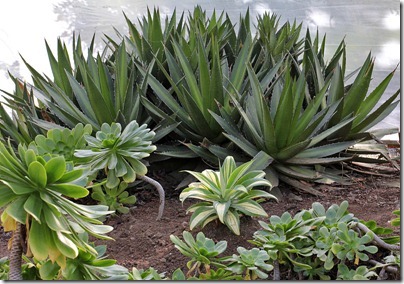Yesterday I had a meeting in the East Bay, so I decided to swing by the Ruth Bancroft Garden in Walnut Creek to see the garden in the winter. I’d last been there in July when everything was baking in the summer heat.
In the winter, things are decidedly different. For one, I was the only visitor. The only other people there were a few volunteers doing chores like weeding, removing dead plant material, etc. In addition, many plants were covered against the frost as much as against excess water. As you can see in the photos below, this ranged from simple boxes for individual specimens to covering an entire area, in essence turning into into a temporary greenhouse.
When Ruth Bancroft created the garden more than 50 years ago, hundreds of tons of crushed rock were brought in from Mount Diablo just a few miles to the southeast to amend the heavy local soil and to improve drainage. Over the years, additional quantities of rock have been added. Many beds are mounded to varying degrees in order to prevent plants from becoming water-logged during our wet winters. Most types of succulents make do with little water in the summer; the real enemy is too much moisture in the winter.
 |
| Looking south from the entrance |
 |
| Group of golden barrel cactus (Echinocactus grusonii) near the entrance |
 |
| As you can see, they are simply covered with semi-transparent plastic and tied at the bottom to keep the plastic in place. |
 |
| I was a bit surprised seeing the plastic so tightly wrapped around the golden barrels. I would have thought that the plastic touching the plants during a frosty night would cause damage, but that doesn’t seem to be a concern with cacti—and neither, apparently, is the lack of breathability of the plastic. The overriding concern is to protect these cacti from excess water; frost protection isn’t an issue here since golden barrels are hardy into the high teens. |
 |
| A more open shelter. Underneath are coral aloes (Aloe striata), hardy to 24°F or so. As winter growers, they are used to receiving moisture in the winter. There must be a good reason for covering them, but I wasn’t able to figure it out. The three coral aloes in our garden are completely exposed in the winter, and they’re just fine. In fact, their leaves are engorged right now from all the extra water they’ve received. |
 |
| A frost protection box for a Sunburst aeonium. Aeoniums are touchy about frost; they sustain damage at 28°F and go to mush not far below that. |
 |
| In the summer this is a shade area to shelter more tender plants from the hot afternoon sun. In the winter, it is completely enclosed to provide frost protection. |
 |
| Essentially, this area becomes a temporary greenhouse. Some plants in here would do just fine outside, for example the large variegated century plant (Agave americana 'Marginata'). |
 |
| The sun casts beautiful shadows on the walls of the structure. |
 |
| Agave and aeonium planting inside the covered area. The beautiful clump in the back is Agave lophantha. However, the smaller agave in the middle is the real star here. It is a perfect specimen of the rare variegated foxtail agave (Agave attenuata 'Variegata'). It’s only the second one I’ve ever seen. I wish I could have gotten a little closer but I didn’t want to leave the path and trample through the planting bed. |
Coming tomorrow, 2/5/11: Lots of echeverias. I took photos of at least a dozen different species/hybrids, and I’m sure there were more that I missed. Echeverias are very popular, judging from the constant stream of new cultivars coming on the market, and it’s easy to see why.











I suppose they've been protecting the plants here this way for decades, right?
ReplyDeleteI wish I had a staff to help me with these types of things. =)
___________________________
It's not work, it's gardening!
.
Alan, yes, I'm sure everything they do is by design, based on many years of experience.
ReplyDeleteIf I lived a little closer (I'm an hour away), I'd volunteer, too. Heck, I may do it anyway. Just being there is awesome.
Very happy to discover your blog, Gerhard!
ReplyDeleteThese protecting boxes are beautiful. I'd love to be in California at that time of the year, when everything is frozen in France :-)
Gabriel
Gabriel, welcome to my blog! I'm very happy to have you as a reader.
ReplyDeleteI really like those boxes, too. I've started to collect some smaller cacti which will be outside round year, and I will build something similar in the winter to protect them from the rain.
Hello Gerhard, Great to see your visit of our garden resulted in this informative blog post with some good pictures.
ReplyDeletePlease let your fellow succulent loving friends know we are available for any question they might have about growing succulents.
With regards,
Freya van Dien, Volunteer Coordinator The Ruth Bancroft Garden
Freya, thank you so much for your reply. I'm glad you found this post. I forgot to ask you for your email address when I ran into your at RBG on Thursday, otherwise I would have e-mailed you a link.
ReplyDelete